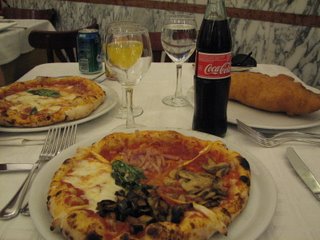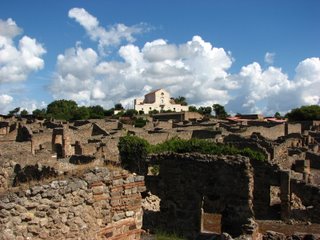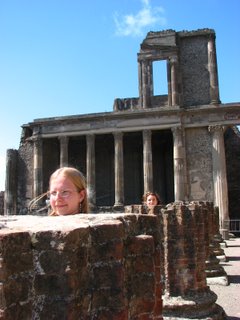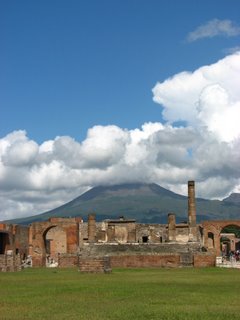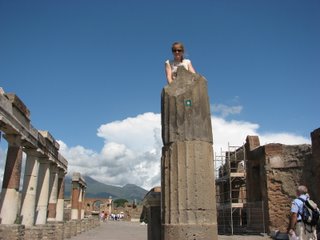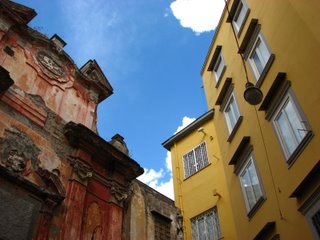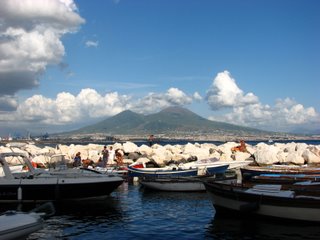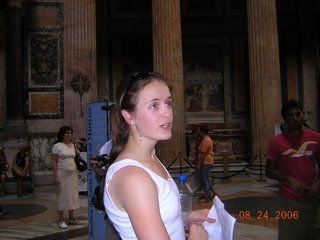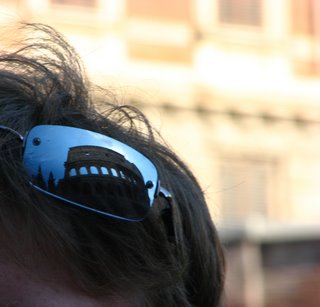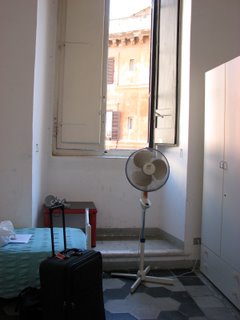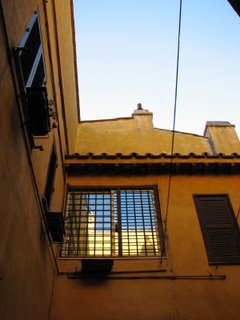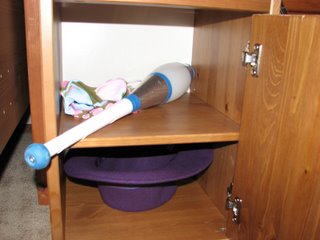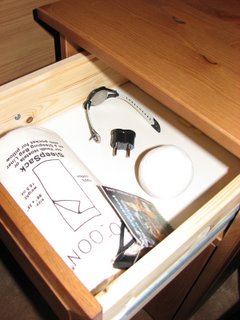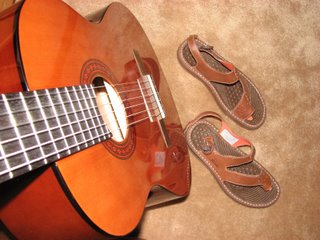In case you people were interested in learning about the Pantheon, here's a little essay I wrote about it. This essay is mandatory, and I am required to put it up. I apologize for the length.
Here it is:
“The Most Celebrated Edifice in the World”
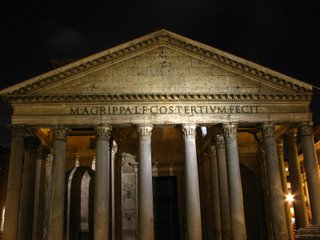
A photo of the Pantheon at night.
The Roman Civilization has undoubtedly impacted how people experience their lives today. But nowhere is this impact stronger than in the buildings and art that we see. One particular building has had a profound influence on such monumental structures such as St. Peter’s building in Rome and the capitol building in America: the Pantheon. A monument in itself, the Pantheon is the best preserved of all ancient Roman structures. It is a cultural, architectural and engineering icon. So, why do people like the Pantheon so much? Because people’s tastes are so different, there cannot be one absolute explanation. But perhaps
understanding one possible purpose of the pantheon might enable us to discern some basic principles that drive the pantheon’s appeal. One purpose of the Pantheon is to represent authority. By demonstrating power, relating the Roman Empire to the heavens and combining both Greek and Roman architecture into one building, Hadrian built the Pantheon as a representation of Rome’s universal authority over the Roman Empire.
However, before I begin, I’d like to define what I’m arguing about. Many disagreements arise between two parties because they are using different definitions for their terms, and so before we begin I’d like to explain what I mean by “authority”. I define authority as the ability of someone to easily extract obedience from others based off of others’ belief that this person is for some reason allowed to command them. Hadrian would certainly need as much authority as possible in order to execute his orders with minimal resistance.

Photo of a bust of Hadrian
Now that we know what we’re arguing about, let us all play a quick game of catch-up as we review the Pantheon’s dramatic history. The emperor who first built the pantheon was actually Marcus Agrippa. Agrippa built the Pantheon in 25 BC., but after burning down, being restored, and again being struck down by lightning, the Pantheon could hardly be called a building when Hadrian came to power (DuTemple 9). Recognizing that this charred rubble might not reflect well on the glory of the Roman empire, Hadrian decided to redesign and rebuild the Pantheon from the foundation up. Nobody knows the details of who designed the Pantheon, or when
exactly building began, but it is generally agreed that the idea of the Pantheon was Hadrian’s, and that building started around 118 AD and ended around 128 AD (MacDonald 12)(DuTemple 24). Time passed, and eventually the Pantheon fell into disrepair along with the Roman Empire. The flooding of the Tiber river raised the ground around the pantheon, and the rain through the oculus combined with the soil that somehow was deposited in the dome nurtured a small forest within the pantheon’s heavenly confines (DuTemple 58). The Pantheon was finally saved when in the year 609 Emperor Phocas (the emperor of Byzantium) gave permission for Pope Boniface IV to consecrate the Pantheon as a church (MacDonald 14). This helped greatly to preserve the Pantheon until a few decades ago when it was restored to its current state. Thanks to looters and the Tiber’s regular flooding, the pantheon today is significantly less decorated and sits much lower than it did during Hadrian’s rule, but except for these minor differences, the Pantheon is essentially the same as it was almost 2000 years ago.
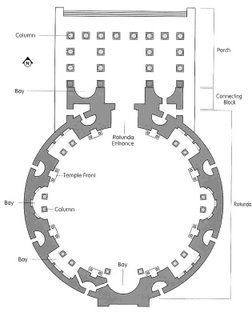
A marked floor plan of the Pantheon
The Pantheon itself is made up of three distinct sections: the porch, the domed rotunda, and the intermediate block which connects the two. The Pantheon was originally situated on top of a flight of steep stairs, which led to the front porch. This flight of stairs gave the ancient roman viewer quite an imposing impression of the Pantheon. The Pantheon’s front porch is similar to a traditional Roman temple borrowed from the Greek form. In front are eight gigantic marble monolithic columns which carry a triangular stone pediment. Behind the first row of columns are two additional rows of four columns each which form three aisles leading up to the temple front (MacDonald 28). The marble monoliths represent immense power because of their size, which only a very powerful and wealthy empire could afford to quarry, carve, and then roll on logs all the way from Egypt.
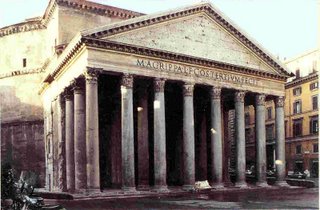
The Pantheon's porch, and Agrippa's inscription
The front of the stone pediment bears its founder’s signature: “M AGRIPPA LF COS TERTIUM FECIT (Marcus Agrippa, consul for the third time, built this)” (Macdonald 13). Why Hadrian chose Agrippa’s name instead of his own is a mystery. One scholar argues that “[Hadrian] wanted it understood as a restoration of Agrippa’s building is in keeping with his intention of vindicating the Imperial order” (McEwen 60). Because Marcus Agrippa was a close friend of Octavian Augustus, Rome’s first and greatest emperor, putting Agrippa’s name on the Pantheon connects the Pantheon to the Roman Emperor, and where he resided: Rome. This, combined with the Pantheon’s location (it is in the very center of Rome) made the Pantheon a building closely connected to the heart of the Roman Empire: Rome.
One other interesting fact about the Pantheon’s porch is that Hadrian made a special effort to turn the Pantheon’s porch around to make it face north, which in the Etruscan sky system is where Janus, the god of doorways, resides (McEwen 62). To ancient Romans, for whom the Etruscan sky system was quite important, this coincidental cardinality served to intimately connect the Pantheon with the sky and thus the gods.
Two of the best ways to demonstrate authority are to demonstrate power and a connection to the gods, because both imply control over others. Because the Pantheon’s porch demonstrates both of the above aspects and connects itself to Rome, the porch is a very strong demonstration of authority of Rome over the Empire.
But the most amazing part of the Pantheon is the domed rotunda that the porch leads into. From the outside, the rotunda is a cylindrical wall of brick with openings strewn here and there, and a bowl-shaped dome (MacDonald 33). A little more than half of the dome is made up of step-like circular rings, which was yet another engineering trick used in the Pantheon to support the massive dome. (MacDonald 33). At the very top of this dome is a giant hole called an oculus 30 feet in diameter which leads inside.
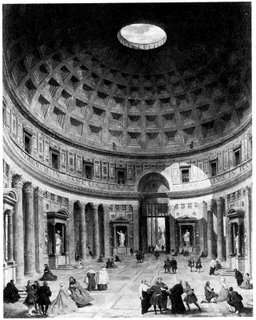
A painting of the Pantheon's dome (interior).
The dome’s modest bowl-shaped exterior completely belies the spherical dome inside. The rotunda itself is a behemoth of a structure “The rotunda of the Pantheon rests of a large circle of concrete There are, by calculation about 10,000 metric tons of it”(McEwen 63). These 10,000 metrics tons were needed simply as a foundation to hold up the building. The rotunda itself was 147 feet in diameter, and was as tall as it was wide. The large proportions of the building are yet another display of the Empire’s vast resources and power.
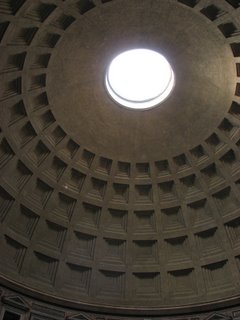
The pantheon's spherical dome with its square recesses (called coffers)
The spherical dome, tiled with small square recesses, is awe-inspiring. During Hadrian’s time, building such a perfectly shaped dome must have been an incredible challenge, and would only have been done for a very good reason. One possibility for making the dome spherical was to connect the Pantheon more closely with the heavens, which the Romans believed to be spherical at the time (DuTemple 6). Cassius Dio, a historian who lived about 100 years after Hadrian, says, “[the Pantheon’s] vaulted roof resembles the heavens” (McEwen 65). Some scholars have even gone as far as arguing that there are sixteen divisions in the Pantheon which correspond to the 16 parts of the Etruscan sky, which was the celestial world in which the gods resided (McEwen 61). The oculus in the very center of the dome is another costly design choice (it necessitated a drainage system for when it rained) which probably was meant to connect the Pantheon to the heavens. “The sun, said the ancients, is the eye of Zeus, and in Hadrian’s Pantheon the greatest of gods was epiphanized in light.” (MacDonald 91). Including the oculus brought the greatest of the gods down to earth in an almost tangible form. The Pantheon’s dome, like the porch, represents power and again links the Roman Empire to the omnipotent gods watching over. The size and spherical dome give such a strong impression that again the power and gods the dome represents make it a very strong symbol of authority.
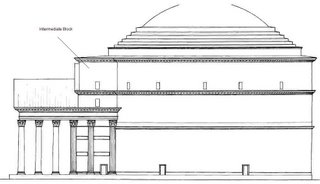
A diagram of the Pantheon (side view) with the intermediate wall marked
The third and most intriguing portion of the Pantheon is the intermediate block which connects the porch to the Rotunda. It is a rectangular block with some stairs and two rooms. What is fascinating though, is what this connection of the porch and dome implies. By combining the more roman dome with the Greek temple entrance, Hadrian was blending the two greatest civilizations together to create the most symbolically powerful building in Rome. “Hadrian’s Pantheon stood at the center, the symbol above all others of that lost age when Mediterranean lands and Europe were united”(MacDonald 24). The Pantheon is a symbol for not one but two empires, and whenever people look at it now, or then, they relate the building to these Empires, and to the power and authority that goes with them.
Of course, the Pantheon wasn’t just a monument for ancient Romans to look at; it was actually used by both Hadrian and the public for many purposes. Ostensibly, the Pantheon is a Roman temple. In fact the etymology of the word ‘pantheon’ means ‘all gods’, and it was, as its name suggested, a temple for all the gods (DuTemple p9). However, “the Pantheon also served as one of the emperor’s official places of business. “Hadrian wanted to see the heavens and the Roman Empire represented in the same place” (DuTemple 6). The Pantheon was used (and some scholars even argue it was meant) as an audience hall, and “Cassius Dio tells us that Hadrian used to hold court [in the Pantheon]”(McEwen 57)(Leacroft 45). Today the Pantheon is still a Catholic church, holding services on Sundays and holidays, but most of the time it is filled with wide-eyed people of all religions, from all around the world. Even though the Pantheon was a temple, it was still very much a place for people. Not only did Hadrian hold court here, but Raphael, King Victor Emmanual II (the first king of Italy), and Umberto I were actually buried underneath the Pantheon (MacDonald 18). The Pantheon was a place for the people and for the gods, further connecting Rome with the gods. Once again, because the gods have control over the people, and the Rome is related to the gods, citizens would see in the pantheon a reminder that just like the gods, the empire is something that needs to be unequivocally obeyed. Even in its use the Pantheon represented (and still represents) authority.
However, Hadrian probably wouldn’t spend so much of Rome’s effort on a building that represented authority if he didn’t need it in the first place. But Hadrian did need a building which represented universal authority. Despite his genius, Hadrian was an unpopular emperor for several reasons. First, Hadrian did not want to continue expanding Rome as his predecessor Trajan had done. Hadrian ruled in the heyday of the Roman Empire, and “He had already made it clear that he favored a policy of ‘peace retrenchment and reform’”(Perowne 47). Hadrian built structures such as the Roman wall in England to mark off his borders and keep the barbaric Europeans from coming in. This was an incredibly unpopular decision because Romans didn’t see progress in an Empire that wasn’t expanding its borders. Also, some people doubted the legitimacy of Trajan’s adoption of Hadrian as emperor, and thought he was a fake. In fact, four senators even plotted to assassinate Hadrian. These popular senators were quickly put to death after news of the plot got to Hadrian, which created even more resentment for the emperor (DuTemple 14).
To maintain power, Hadrian needed a building to demonstrate that he was still incredibly powerful and should be obeyed. And since “the Roman Empire was at the height of its powers…A newly designed Pantheon, perfect in its construction and stunning in its beauty, could reflect the symmetry and power of the Roman Empire”(Dutemple 9).
One final motivation for building the Pantheon as a symbol for authority was that Hadrian needed to support his view of Rome as the supreme authority over the entire empire. “Hadrian was an innovator…he had conceived a new form of polity, namely the empire as a family of provinces, the happy the prosperous children of the mother City, and of himself as its lord, should be the spiritual bond of the empire” (Perowne 67). Furthermore, Hadrian believed that the provinces of Rome should all be equal, and should “all be bound to the emperor not as to a master by fear, but as to a father by love” (Perowne 54). The Pantheon, powerful yet divine, was the exact awe-inspiring structure Hadrian needed. When he came to power, “Hadrian…knew well that is his idea of empire was to prevail, it must be demonstrated on the spot” (Perowne 67). One of the first buildings Hadrian built was the Pantheon, and it very likely that he built it for the purpose of demonstrating his idea of Rome as the supreme authority.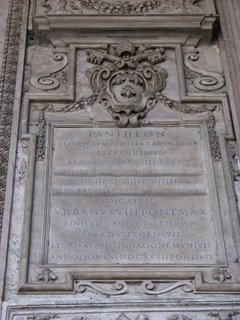
A photo of Urban VIII's inscription
At the back of the Pantheon’s porch, just to the right of the great bronze doors is an inscription made in 1632, created by Urban VIII, which reads, “The Pantheon [is] the most celebrated edifice in the world” (MacDonald 94). This statement can be confirmed with a quick glance at the illustrations of any book on the history of architecture to see the countless domed rotundas with temple-front porches (MacDonald 94). “It is one of the few archetypal images in Western culture” (MacDonald 94). Why has it been so influential? Nobody knows for sure, but we do have a few hints. First, “the Pantheon motif can be seen wherever authority, ecclesiastical or political demand a recognizable, stately architectural imagery” (MacDonald 131). Second, that by connecting the Greek and Roman cultures, and Rome with the Gods, Hadrian built the Pantheon as a symbol of authority to support the autority of the Roman Empire. The Pantheon was built for the gods, but its real audience was the people. It was built as a symbol not of the glory of Rome, but of the Roman Empire’s authority. Perhaps this might explain why we use this temple-front dome so much.
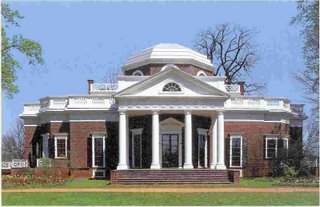
Thomas Jefferson's Monticello. Can you see the resemblence?
Works Cited
Davies, Paul, David Hemsoll, and Mark Wilson Jones, “The Pantheon: Triumph of Rome or Triumph of Compromise”, Art History, v. 10, June, 1987.
DuTemple, Lesley. The Pantheon. Minneapolis: Lerner Publications Company, 2003.
Leacroft, Helen and Richard. The Buildings of Ancient Rome. Leicester: Brockhampton Press, 1969.
MacDonald, William. The Pantheon: Design, Meaning, and Progeny. Cambridge: Harvard University Press, 1967.
McEwen, Indra Kagis, "Hadrian's Rhetoric I: The Pantheon", RES, vol. 24, Autumn, 1993.
Perowne, Stuart. Hadrian. London: Hodder and Stoughton, 1960.










